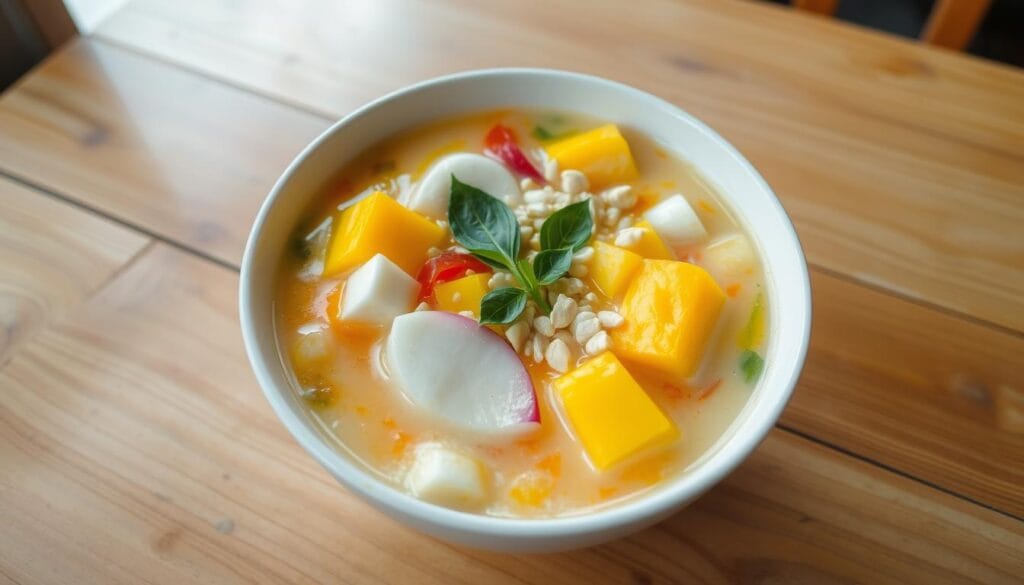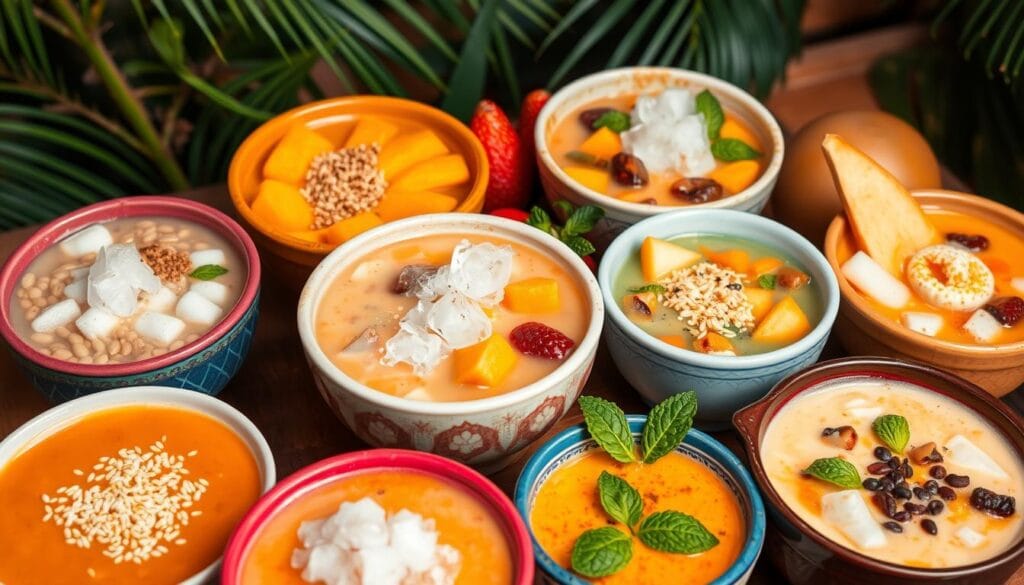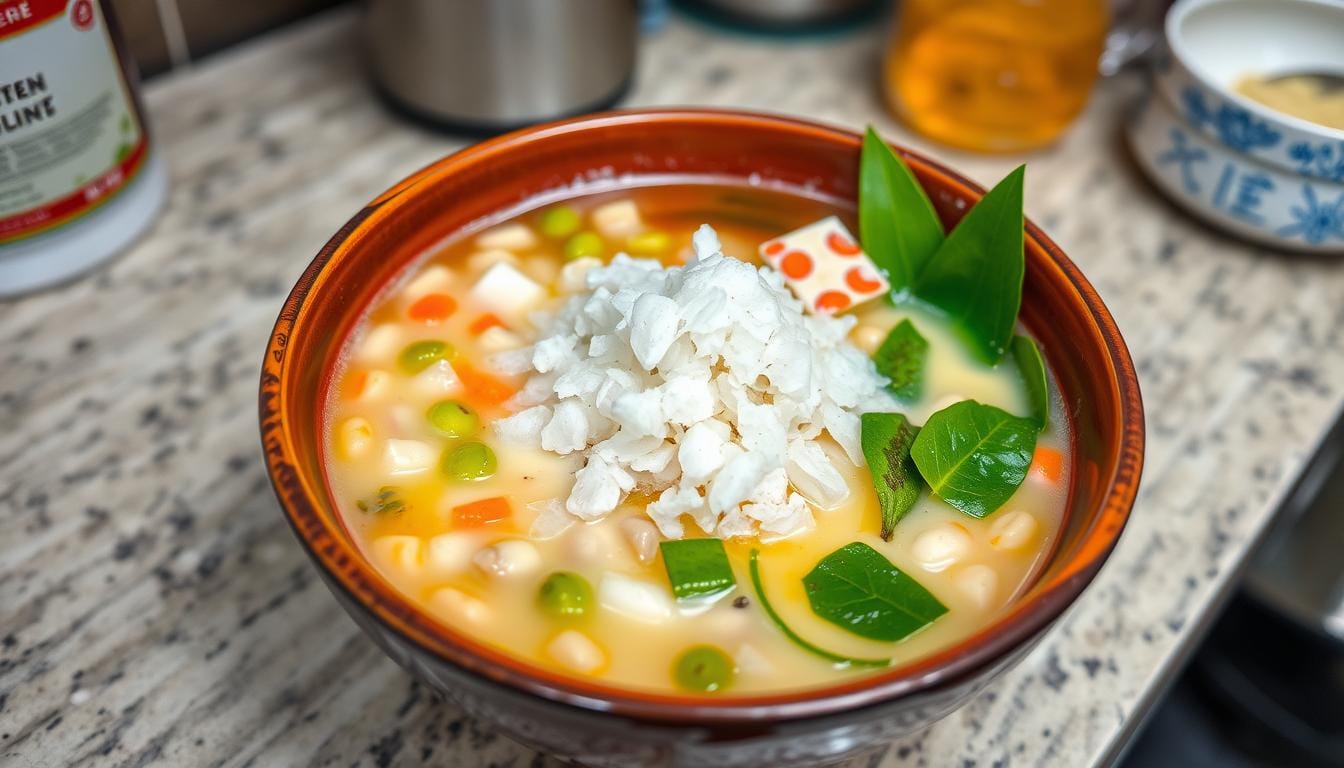Exploring traditional Vietnamese desserts leads to the delightful Vietnamese Sweet Soup, or chè. This beloved dessert has been a staple in Vietnamese cuisine for centuries. It offers a wide range of flavors and textures, pleasing many tastes and preferences. Vietnamese Sweet Soup is not just a dessert; it’s an experience waiting to be discovered.
Vietnamese Sweet Soup combines creamy coconut milk with the natural sweetness of tropical fruits. It’s a true reflection of Vietnam’s culinary heritage. Over time, chè has evolved, adding modern twists while keeping its traditional essence. It’s a great choice for those seeking a delicious, vegan-friendly treat.
Table of Contents
What is Vietnamese Sweet Soup?
Vietnamese cuisine is famous for its fresh, simple flavors. Sweet soups are a big part of desserts and snacks. Each sweet soup recipe has its own special twist, making them a favorite in Vietnamese food.
Sweet soups in Vietnamese cuisine are often desserts or snacks. They use ingredients like coconut milk, beans, fruits, and tapioca. This mix creates a tasty and cool sweet soup perfect for any time.
Overview of Vietnamese Cuisine
Vietnamese food is known for its light, fresh tastes. It focuses on herbs, veggies, and seafood. Sweet soups are a big part of desserts, adding many flavors and textures.
Significance of Sweet Soups
Sweet soups, or che, are a key part of Vietnamese cuisine. They range from simple coconut milk soups to complex desserts. Che shows the creativity and variety of Vietnamese food.
Common Ingredients
Ingredients like coconut milk, mung beans, red beans, and tapioca pearls are common in sweet soups. Fruits like mango, durian, and jackfruit add sweetness and flavor. With so many choices, you’re bound to find a sweet soup you like.

| Ingredient | Quantity |
|---|---|
| Coconut milk | 1 cup |
| Mung beans | 1/2 cup |
| Tapioca pearls | 1/4 cup |
Popular Types of Vietnamese Sweet Soup
Vietnamese sweet soup, known as chè, offers a wide range of sweet soup variations. These variations cater to different tastes and preferences. Chè is a popular Vietnamese dessert that has become a big part of the country’s food culture.
Some well-known types of chè include Chè Thập Cẩm, Chè Bắp, Chè Đậu Xanh, and Chè Sầu Riêng. These sweet soup variations are not only tasty but also show off Vietnam’s rich food heritage. Whether you like your chè hot or cold, there’s a popular Vietnamese dessert for you to try.

- Chè Thập Cẩm: A mixed sweet soup with beans, fruits, and tubers.
- Chè Bắp: A sweet corn soup great for hot summer days.
- Chè Đậu Xanh: A mung bean soup rich in nutrients and flavor.
- Chè Sầu Riêng: A durian sweet soup for the adventurous.
Thesepopular Vietnamese dessertoptions are just a few examples of Vietnam’s manysweet soup variations. With its rich flavors and diverse ingredients, chè is a culinary experience you won’t want to miss.
Essential Ingredients for Making Sweet Soup
In Vietnamese cooking, a sweet soup recipe needs the right ingredients. You’ll need beans and pulses like mung beans and red beans. These add nutrition and make the soup filling. Coconut milk is also key, giving the soup a rich, creamy texture.
The ingredients used in Vietnamese cooking greatly affect the flavor and texture of sweet soup. Fruits like bananas, mangoes, and durians add natural sweetness and flavor. Toppings such as sesame seeds, crushed peanuts, and coconut flakes add crunch and depth. Having these ingredients is essential for a delicious sweet soup.
- Beans and pulses, such as mung beans and red beans
- Coconut milk for creaminess
- Fruits like bananas, mangoes, and durians for natural sweetness and flavor
- Toppings such as sesame seeds, crushed peanuts, and coconut flakes for added texture
By using these essential ingredients, you can make a delicious and authentic Vietnamese sweet soup. It’s sure to be a hit with everyone.
The Cultural Significance of Sweet Soup
Chè is a beloved traditional Vietnamese dessert. It’s often enjoyed at celebrations and festivals. It brings families and friends together, symbolizing love and unity.
In Vietnam, chè is a big part of daily life. Different regions have their own special versions. They use local ingredients and cooking methods to make unique flavors and textures.
Some popular types of chè include:
- Chè Thập Cẩm: a mixed sweet soup featuring a variety of ingredients such as beans, tubers, and fruits
- Chè Bắp: a sweet corn soup made with fresh corn, sugar, and coconut milk
- Chè Đậu Xanh: a mung bean soup flavored with sugar, coconut milk, and a touch of salt
Chè is not just a treat; it’s also nutritious. It gives you energy and keeps you full for a long time. Its rich flavors and variety of ingredients make it a favorite among all ages.
| Type of Chè | Ingredients | Region |
|---|---|---|
| Chè Thập Cẩm | Beans, tubers, fruits | National |
| Chè Bắp | Fresh corn, sugar, coconut milk | Central |
| Chè Đậu Xanh | Mung beans, sugar, coconut milk | Southern |
How to Serve Vietnamese Sweet Soup
Serving Vietnamese sweet soup is all about the presentation. Traditionally, it’s served in small, delicate bowls. These bowls are made for holding in your hands, making the dessert experience more intimate.
These soups are often topped with coconut milk, crushed ice, and fresh fruits. Coconut milk adds richness, while crushed ice cools down the soup. Fresh fruits burst with flavor and color. This makes Vietnamese sweet soups a refreshing treat any time of day.
Popular toppings include coconut milk, crushed ice, and fresh fruits like mango or durian. You can also add sesame seeds or peanuts for crunch. Mixing these toppings creates a unique and tasty experience. Whether it’s a traditional or modern twist, the fun lies in trying new flavors and textures.
| Topping | Description |
|---|---|
| Coconut milk | Adds richness and creaminess to the soup |
| Crushed ice | Provides a cooling contrast to the warm soup |
| Fresh fruits | Contributes bursts of flavor and color to the soup |
By trying different toppings and accompaniments, you can make a delicious Vietnamese sweet soup. It’s a great way to enjoy the best of Vietnamese and Asian desserts.
Making Vietnamese Sweet Soup at Home
To make a delicious Vietnamese sweet soup at home, start with a simple recipe. You’ll need 1 lb of salmon head or large catfish steak, 1/2 tablespoon of sesame oil, and 4 cups of water. You can also add optional ingredients like 1 tablespoon plus of tamarind concentrate, 1 cup of chopped pineapple, and 1 medium-large tomato, cut into smaller pieces.
Here are some steps to follow for a basic sweet soup recipe:
- Lightly boil the catfish steaks for approximately 5 minutes before adding additional ingredients.
- Add the sesame oil, tamarind concentrate, pineapple, and tomato to the soup base and simmer for 10-15 minutes.
- Season with fish sauce to taste, and adjust the sweetness and sourness as needed.
For a vegan version, use coconut milk, tapioca pearls, and banana slices. Cook the tapioca pearls in water until they are translucent. Then, simmer the banana slices in coconut milk until they are tender. Combine the two mixtures and add sugar to taste.
With these simple steps and ingredients, you can make a delicious Vietnamese sweet soup at home. Use a traditional sweet soup recipe and Vietnamese cooking techniques.
| Ingredient | Quantity |
|---|---|
| Sesame oil | 1/2 tablespoon |
| Tamarind concentrate | 1 tablespoon plus |
| Pineapple | 1 cup, chopped |
| Tomato | 1 medium-large, cut into smaller pieces |
Sweet Soup Variations Across Regions
Vietnamese sweet soup is a beloved dessert with many variations. Each one shows the unique culture and geography of its region. In the north, soups are heartier, with ingredients like mung beans and lotus seeds.
In the central region, soups feature tropical fruits and coconut milk. This makes for a refreshing and rich dessert. The south, with its fertile delta and coastline, offers soups with fresh seafood and fruits. It’s a must-try for any dessert lover.
Some favorites include Chè Thập Cẩm, a mixed sweet soup, and Chè Đậu Xanh, a mung bean soup. These soups are not just tasty but also highlight the diversity of Vietnamese cuisine. They’re a favorite among dessert enthusiasts.
| Region | Sweet Soup Variation | Ingredients |
|---|---|---|
| Northern | Chè Đậu Xanh | Mung beans, sugar, coconut milk |
| Central | Chè Thập Cẩm | Tropical fruits, coconut milk, tapioca pearls |
| Southern | Chè Bắp | Sweet corn, coconut milk, sugar |
Pairing Vietnamese Sweet Soup with Other Dishes
Enjoying Vietnamese sweet soup is even better when you pair it with other dishes. These pairings enhance the flavors and textures of the soup. In Vietnamese cuisine, sweet soups are often desserts or snacks. But they also go well with savory dishes for a complete meal.
Popular pairings include spring rolls, grilled meats, and steamed rice. These dishes balance the sweetness of the soup. For those new to Asian desserts, Vietnamese sweet soup is a great introduction.
Here are some tips for pairing Vietnamese sweet soup with other dishes:
- Choose dishes with complementary flavors and textures, such as savory and sweet or crunchy and smooth.
- Consider the occasion and the company, and choose dishes that are appropriate for the setting.
- Don’t be afraid to experiment and try new combinations – you might be surprised at how well certain dishes pair together!
For drinks, Vietnamese coffee or tea are great with sweet soup. They add a refreshing and caffeine boost to the meal.
| Dish | Pairing Suggestions |
|---|---|
| Vietnamese Sweet Soup | Spring rolls, grilled meats, steamed rice |
| Vietnamese Coffee | Sweet soup, desserts, or as a digestif |
Health Benefits of Vietnamese Sweet Soup
Exploring Vietnamese desserts, you’ll find many sweet soups are healthy. They use beans, fruits, and coconut milk. These ingredients add fiber, protein, and healthy fats to the soups.
Looking for a healthy dessert? Vietnamese sweet soups are perfect.
These soups have many health benefits. They include:
- High fiber from beans and fruits, aiding digestion and keeping you full
- Protein from beans and coconut milk, helping muscles grow and repair
- Healthy fats from coconut milk, lowering cholesterol and improving heart health
They are also low in calories and full of vitamins and minerals. For instance, a serving can have 16g of sugar, 5g of fiber, and 1563 IU of vitamin A. This makes Vietnamese sweet soups a top pick for healthy desserts.
Want a tasty and nutritious dessert or a healthy sweet alternative? Vietnamese sweet soups are ideal. They offer a unique mix of ingredients and health benefits. Enjoying them can satisfy your sweet cravings while boosting your health and wellbeing.
Exploring Vietnamese Sweet Soup in Restaurants
Exploring Vietnamese desserts is a must for food lovers visiting the country. You’ll find sweet soup, or “Chè,” in many places. These treats mix flavors and textures in unique ways, showing off Vietnamese cooking skills.
For the best Chè experience, look for local eateries and traditional spots. These places keep authentic recipes alive. They take you straight to the heart of Vietnam’s dessert culture.
When trying sweet soup, think about the ingredients and how it’s made. Each type offers a different taste adventure. Try Chè Bưởi for a refreshing taste or Chè Sầu Riêng for something richer. Enjoy it with jasmine tea or coconut water for a complete experience.
FAQ
What is sweet soup in Vietnam?
Sweet soup, known as “Chè” in Vietnam, is a popular dessert consisting of a variety of sweet ingredients served in a soup or pudding-like consistency. Chè can include beans, coconut milk, tapioca pearls, fruits, jellies, and even sweetened rice. It is typically served chilled or over ice, making it a refreshing treat in Vietnam’s warm climate.
What is the most famous Vietnamese dessert?
One of the most famous Vietnamese desserts is Chè Ba Màu (Three-Color Dessert). This vibrant dessert consists of layers of mung bean paste, red beans, and pandan jelly, topped with crushed ice and sweet coconut milk. It’s loved for its unique textures, flavors, and eye-catching presentation.
What is the name of the Vietnamese soup?
The general term for Vietnamese sweet soup is “Chè.” There are many varieties of Chè, including Chè Thái (fruit cocktail with coconut milk), Chè Trôi Nước (glutinous rice balls in sweet ginger syrup), and Chè Bắp (sweet corn pudding). These desserts are an essential part of Vietnamese cuisine and are enjoyed year-round.
What is the national dessert of Vietnam?
While Vietnam does not officially have a national dessert, Chè is widely regarded as one of the most iconic sweets in Vietnamese cuisine. Its endless variations and deep cultural significance make it a staple in Vietnamese celebrations and daily life. Another contender is Bánh Flan, a caramel custard dessert with a Vietnamese twist, often made with coconut milk.

